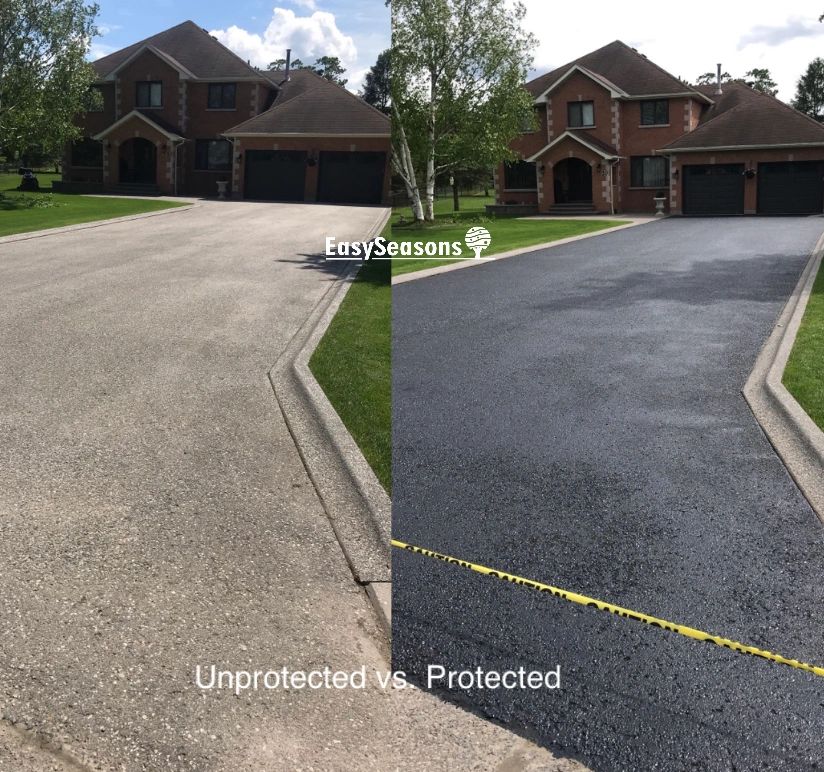Discover the Power of Industrial Parking Area Paving and Asphalt Sealing
Wiki Article
Warm Mix Asphalt: A Lasting Option for Sidewalk
Warm Mix Asphalt (HMA) has emerged as a leading lasting choice for sidewalk options, offering a myriad of ingenious technologies and ecological benefits. As the need for environment-friendly construction techniques grows, discovering the nuances of HMA's sustainability can give beneficial insights right into the future of pavement remedies.Environmental Advantages of Hot Mix Asphalt

Furthermore, Warm Mix Asphalt helps to minimize metropolitan warmth island impacts. Its dark color takes in sunshine, decreasing the quantity of warm reflected back right into the atmosphere contrasted to lighter-colored pavements. This can reduce ambient temperature levels in metropolitan locations, reducing the need for air conditioning and inevitably minimizing energy usage.
Furthermore, Hot Mix Asphalt adds to improved stormwater management. Its permeable nature permits water to infiltrate the sidewalk and reenergize groundwater supplies, decreasing overflow and the threat of flooding. These environmental advantages make Warm Mix Asphalt a sustainable option for paving highways and roads.
Energy Efficiency in HMA Manufacturing
Is power effectiveness an essential variable in the manufacturing of Hot Mix Asphalt (HMA)? Energy plays a considerable function in the production of HMA, impacting both cost and environmental sustainability. One key aspect of energy performance in HMA manufacturing is the usage of cozy mix asphalt (WMA) innovations.Moreover, improvements in plant innovations have led to even more energy-efficient HMA production procedures. Modern plants are made with attributes like recycled asphalt sidewalk (RAP) handling capabilities, reliable heater systems, and enhanced insulation, all adding to energy cost savings. By optimizing energy usage in HMA manufacturing, the market can minimize its carbon impact while keeping top notch pavement products. Power efficiency is, for that reason, a critical factor to consider in guaranteeing the sustainability of Warm Mix Asphalt manufacturing.
Recyclability of Warm Mix Asphalt
The recyclability of Hot Mix Asphalt (HMA) is a crucial aspect of its sustainability and long-lasting ecological impact. HMA is among one of the most recycled materials in the United States, with over 100 million bunches of redeemed asphalt pavement (RAP) being recycled each year in new pavement building and construction. Recycling HMA provides a number of ecological benefits, such as decreasing the requirement for virgin products, decreasing energy consumption throughout production, and reducing the amount of waste sent out to garbage dumps.The procedure of recycling HMA involves crushing the existing sidewalk, crushing it into smaller sized items, and linked here mixing it with new accumulation and asphalt binder to produce a recycled mix. Generally, the recyclability of HMA plays a significant role in advertising lasting practices within the sidewalk market.

Long-Term Performance of HMA
Asphalt sidewalks demonstrate longevity and strength over an extensive duration, reflecting the long-term performance of Warm Mix Asphalt (HMA) The long life of HMA can be credited to its capacity to hold up against rush hour lots, severe climate condition, and the effects of aging. Researches have revealed that well-designed and correctly built HMA pavements can last for 20 years or more with normal maintenance. The key to taking full advantage of the long-lasting performance of HMA hinges on utilizing you could try here high-quality products, following finest practices in construction, and implementing efficient maintenance techniques. Appropriate water drainage, routine inspections, and timely repair services are crucial for preserving the structural integrity of HMA sidewalks with time. In addition, improvements in HMA technology, such as making use of polymer-modified binders and warm mix asphalt, have actually further enhanced the resilience and longevity of HMA pavements. By focusing on top quality construction and upkeep practices, HMA remains to confirm itself as a cost-effective and lasting solution for durable sidewalk infrastructure.
HMA: Toughness and Sustainability
Demonstrating both toughness and sustainability, Hot Mix Asphalt (HMA) has actually become a keystone in the building and construction of lasting pavement infrastructures - regrading. HMA's resilience comes from its ability to hold up against heavy loads, harsh climate condition, and high website traffic volumes, making it a trusted selection for streets, highways, and flight terminal paths. The structure of HMA, which typically includes accumulations, binder, and filler, plays a critical function in boosting its durability and resistance to damage
Moreover, HMA's sustainability hinges on its recyclability and energy-efficient production procedure. The capacity to reuse redeemed asphalt pavement (RAP) in brand-new HMA mixtures minimizes the demand for virgin materials and lessens the environmental influence of pavement building and upkeep. In addition, the power efficiency of generating HMA depends on its lower blending temperatures compared to other pavement materials, bring about reduced power intake and greenhouse gas exhausts.
Verdict
In verdict, hot mix asphalt (HMA) provides a sustainable option for pavement with its eco pleasant features. HMA's recyclability, energy performance in production, and long-lasting longevity make it an eco-friendly option for roadway building.
HMA is one of the most recycled materials in the United States, with over 100 million loads of reclaimed this asphalt pavement (RAP) being recycled every year in new sidewalk construction.The process of recycling HMA includes milling the existing sidewalk, squashing it into smaller sized pieces, and blending it with brand-new aggregate and asphalt binder to develop a recycled mix.Asphalt sidewalks demonstrate resilience and resilience over an extensive duration, showing the long-term efficiency of Warm Mix Asphalt (HMA) Additionally, advancements in HMA modern technology, such as the use of polymer-modified binders and cozy mix asphalt, have additionally boosted the sturdiness and longevity of HMA sidewalks. The capability to recycle recovered asphalt pavement (RAP) in new HMA combinations minimizes the need for virgin materials and decreases the ecological influence of pavement building and construction and maintenance.
Report this wiki page